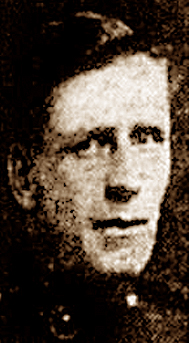L-Cpl Sidney William Barford (pictured), Royal Marines, was awarded the Distinguished Service Medal in November 1918 for sinking a German U-boat off the United States coast the previous August. He was serving in the mercantile marine as a gunner to combat submarines.
The incident was not mentioned in British newspapers at the time of the sinking, but an American journal gave a full account of the incident. This account was eventually reproduced in the Beds & Herts Saturday Telegraph on December 7th, 1918, following the announcement of the award of the DSM.
 Under the heading 'U-boat is sunk by tanker's gun – German raider victim of British vessel's shell fire off New Jersey coast,' the American article read: “One of the submarines operating on the New Jersey coast has been sunk by a British tanker. The crew of the tanker, which has just arrived at an Atlantic port, made this report, saying the U-boat attacked it last Friday, and was sunk by shells fired from the tanker's gun.
Under the heading 'U-boat is sunk by tanker's gun – German raider victim of British vessel's shell fire off New Jersey coast,' the American article read: “One of the submarines operating on the New Jersey coast has been sunk by a British tanker. The crew of the tanker, which has just arrived at an Atlantic port, made this report, saying the U-boat attacked it last Friday, and was sunk by shells fired from the tanker's gun.
For three hours the tanker and the U-boat battled off the coast. Two torpedoes were fired into the vessel, one failing to explode. The other struck an empty tank in the ship. Three more torpedoes launched at the vessel were avoided by quickly changing the course of the tanker.
After the second torpedo had been launched the tanker charged the U-boat. The British gunners aboard began raining shells towards the submarine. It was seen that the shots were going wild, missing the raider by big distances.
Gradually the tanker's fire began to draw closer to the U-boat. Finally there was no splash accompanying the landing of the shells. From this the gunners believed they were hitting the sides of the submersible.
More than 20 shots had been fired when the submarines was seen to keel to an angle that made her resemble a wreck, with her periscope slanting similar to the mast of a derelict schooner.
“Got 'er,” muttered a British gunner when a shot was seen to hurl pieces of the U-boat into the air.
Still at an awkward angle, the submarine went under water. The angle at which it submerged was not a normal position for a dive, according to the crew.
In the course of the battle, the tanker had shifted from a direct charging attitude to one of leading a running battle. She moved not fast, but leisurely away from the submarine, offering the slenderest possible target for the returning fire from the U-boats deck guns, which were used when it was seen that the tanker could dodge torpedoes as easily as it could return the enemy fire.
When the last shower of metal shot up from the U-boat and it went down, the tanker was stopped and started back to the place where the raider last was seen. In a few minutes a mound of bubbles and oil spread over the sea where the U-boat had gone down.
The tanker was on its way to port after having been repaired at a yard in a gulf port. No cargo was aboard.
Sidney Barford was a reservist at the outbreak of war, working at the Balmforth Boiler Works in Luton. He was recalled to the colours, and was engaged on escort duty with transports. He then served in the Dardanelles naval campaign, and went on to Gallipoli with the Naval Division. He was on the peninsular until the evacuation and came through unscathed. Egypt was his next destination and then went to a unit in France, where he was wounded. On recovery he transferred to the mercantile marine as a gunner.
His parents lived at 64 Harcourt Street, Luton, and his father was a member of the Park Street Temple Salvation Army Band. Sidney had three brothers serving - Dvr A. Barford (Royal Engineers), George (in training at Colchester) and Sgt Joseph Henry Barford, a married man who had been awarded the Distinguished Conduct Medal for an act of remarkable daring.
[Beds & Herts Saturday Telegraph: December 7th, 1918]

